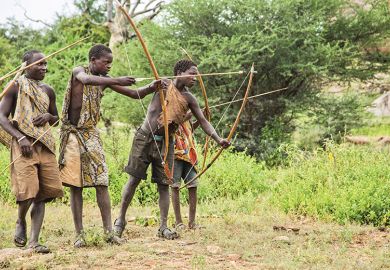He may have been a neurotic, womanising egomaniac, but, as Nigel Barley observes, Tom Harrisson always managed to land on his feet.
Tom Harrisson, the author tells us, was known in England for Mass Observation, internationally for animal conservation, in the South Pacific for his ethnography of the New Hebrides, in Australia for leading units in guerrilla warfare and - one might add - for gross and almost unprecedented offensiveness on all continents. It is a convention of biographies that the subject's actions not be explained simply through his being a) insane, or b) a total swine, and Judith Heimann wisely follows this rule. But it is clear that many of Harrisson's contemporaries invoked precisely these frameworks of explanation when it came to fitting him into a reasonable world view.
Certain biographers might have been tempted to have a little more fun with someone as resolutely self-indulgent as Harrisson, but this is a work of patient and quite exceptional scholarship. Heimann has interviewed just about everyone and read pretty much everything, not just in the personal domain of her subject but in background areas such as general anthropology and ornithology. She worries that William Arens might have got it wrong about cannibalism. Only occasionally does she duck the writs and go for anonymity of informants or publishing the alternative version of the allegedly wronged. Mostly, she makes up her mind what happened and sticks to her guns. It is eminently clear, balanced and consistent - exactly what Harrisson was not.
Harrisson was born in 1911 into a wealthy Anglo-Argentine family, received a Harrow education and got interested early in the great crested grebe. All was well until he went to Oxford. Quite inexplicably, exposure to that institution converted him into a mass of neurosis, pretension and drunken egotism. All his life he would be a rugger hearty, liking the sound of breaking glass, heads and conventions. Leaving without a degree, he drifted into expeditions - the Arctic, Sarawak, Malekula - and heterosexual adultery. Sarawak has often been the unfortunate site for spoiled Brits to stew in their own sexual juices while fretting over their manhoods. Thus it was for the blatantly repressed Rajah Brooke. Thus it was for Harrisson.
In the course of it all, Harrisson wrote his bestselling Savage Civilisation 1937, an ethnographically informed book of travel. He would never know such literary success again. (A biography might well be expected to include a bibliography of the subject's writings, but Heimann notes that the standard version runs to 56 pages.) Observing bird behaviour had led to "native" watching, and this would lead in turn to observing the working class in Bolton. Harrisson became one of the co-inventors of that curiously British version of the social survey called Mass Observation, a misnomer because it consisted of remarkably few informants jotting down a chaotic mix of interviews, observations and diary entries that were then mysteriously condensed into books of generalisations. Heimann is sensitive to the fact that throughout his life Harrisson's mode of academic operation was universally a guerrilla raid into specialist territory already under occupation. Inevitably he would be attacked by those specialists on whose patch he was trespassing and charged with incompetence. Defending her subject, she often seems to go a little far and Harrisson comes dangerously close to inventing ecology, functionalism, anti-imperialism, postmodernism, conservation and new archaeology. The truth is that much of his work was slapdash and quirky, the product of a bush polymath working alone and under impossible conditions. But then, often this was so because he made the conditions impossible and was incapable of working for long with anyone else. "Using other people's work without acknowledgement" is early added to womanising and drunken brutality. Polished editing was never his style. He would be in his element in later life as "the Sarawak man" who would turn his hand to anything from decorating the ceilings of the parliament building to judging lawsuits and breeding turtles.
The second world war saved Harrisson as it saved so many others. The government, in need of information on "morale", was induced to see Mass Observation as a source of such knowledge and threw Harrisson a financial lifeline so that he was able to make the first of a series of marriages that he discarded, one by one, as they ceased to be convenient. When he had offended just about everyone in propaganda and was consequently called up, he was saved again by becoming an "expert" on guerrilla warfare in Sarawak.
This was truly Harrisson's finest hour. He was able to bully and feud splendidly with Australians and Brits, impose lethally harsh conditions on himself and his men, while being absolutely adored by the up-river tribes. Physical feats of endurance and disobeying of orders fed his ego and finally allowed him to think himself worthy of his military father's good opinion. After a "good war" complete with Distinguished Service Order, he became a museum wallah.
From 1947 until the end of the British Raj in 1966, Harrisson was in charge of the Sarawak Museum and ran it with relentless panache and dedication. It became the most lively, interesting and welcoming institution of its kind in Southeast Asia and, indeed, the only one at the time to have a real international presence through its publications (largely ghost-written by Harrisson - the other side of his "plagiarism") and its active research programmes. There can be no doubt of Harrisson's genuine affection for "his" Kelabit people, indeed all those who had yet to be infected - as he saw it - by exposure to the West. That this extended to jealousy when outside scholars tried to make raids on his own patch was inevitable.
I have always been puzzled, when reading the material on Bornean head-hunting, at the sheer oddness of the debate that took place between Harrisson, Edmund Leach, Derek Freemann and, later, Rodney Needham. There is a sinister whiff, at more than one point, not just of a normal anthropological level of eccentricity but of serious mental instability. The missing piece of the jigsaw, it is now clear, is the monstrous and rampaging ego of Harrisson who, even from beyond the grave, imposes himself on the material through the hysterical histrionics he induced in those about him. This would ultimately poison his reputation entirely in Sarawak and get him blacklisted in the country he had done so much to make known. It could not help his image that at the height of a party he invited guests to watch him in action in the bedroom with a local woman, who may or may not have been his wife. But Heimann will not have it that he could be guilty of any of the usual curatorial offences alleged against him after his departure -theft, plagiarism, incompetence and so on. They are all to be explained by his failure to kowtow to Malay sensitivities and by the sheer offensiveness of the man, his bullying, his drinking, his paranoia that induced others to believe him capable of anything. Heimann should know. She once lived next door to him.
After a wretched interval, teaching in America, Harrisson rises again from the ashes, becomes glamorously a "professor" and ducks out of a poverty-stricken and exhausted marriage into a new one with a wealthy and attractive baroness who owns a vintage sports car and an apartment in the south of France. By now, the marital drunken aggression, the scenes and the foul-mouthed recrimination are beginning to seem almost endearing in the OAP from hell, a survivor, to be set alongside the careful notes he keeps on his own sexual performance - suggesting that those allegations of sloppy record-keeping in Sarawak were indeed unfounded. It all ends, as Harrisson must have wished that it would, with a bang not a whimper, a fatal and stupid car crash in Thailand and an incidentally Buddhist incineration followed, inevitably, by the British establishment mouthing pieties.
Nigel Barley is assistant keeper, Museum of Mankind, London.
The Most Offending Soul Alive: Tom Harrisson and his Remarkable Life
Author - Judith Heimann
ISBN - 0 8248 2149 1 and 2199 8
Publisher - University of Hawaii
Price - £35.00 and £16.99
Pages - 468
Register to continue
Why register?
- Registration is free and only takes a moment
- Once registered, you can read 3 articles a month
- Sign up for our newsletter
Subscribe
Or subscribe for unlimited access to:
- Unlimited access to news, views, insights & reviews
- Digital editions
- Digital access to THE’s university and college rankings analysis
Already registered or a current subscriber?



